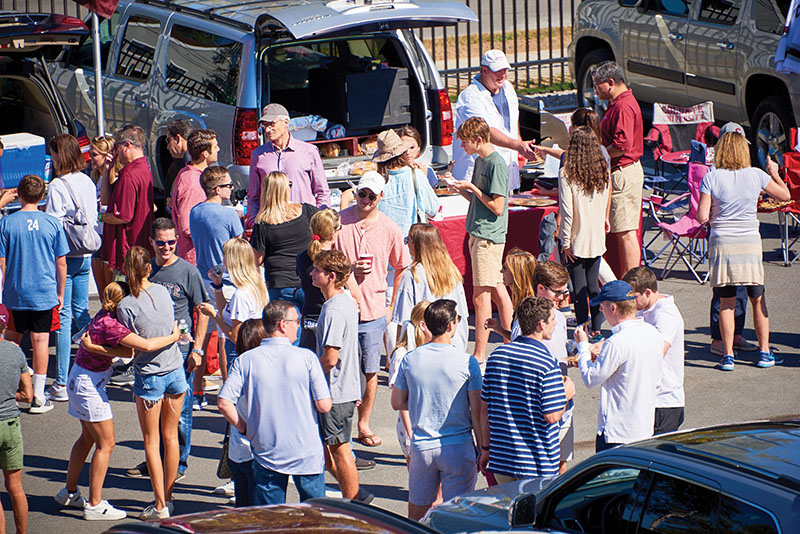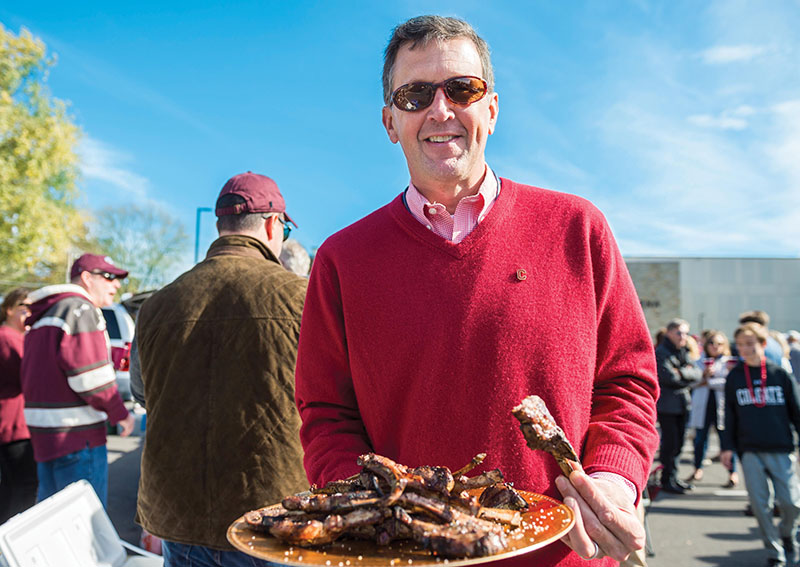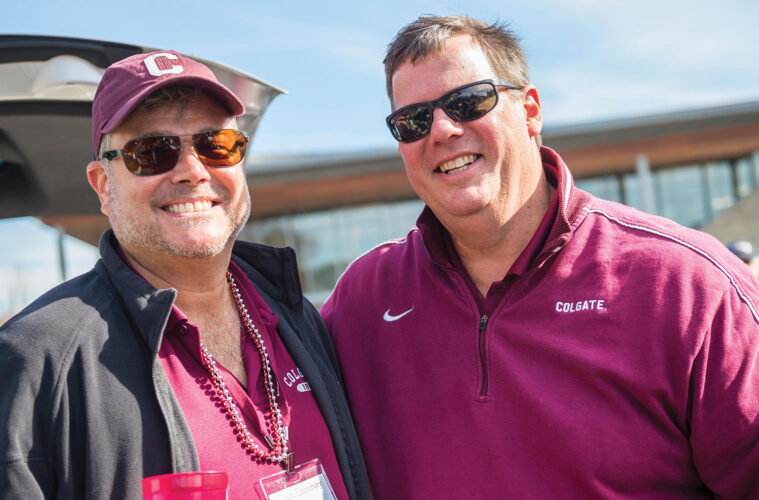When Andy Brummer ’85, P’16 pops his trunk on game day, he’s not pulling out chips and hot dogs. He traded those for juicy jumbo shrimp cocktail and piping hot Philly cheesesteak quesadillas.
Brummer isn’t a professional chef — he’s simply a Raider football fan with a penchant for party planning. “There is nothing more satisfying to me than to execute a party like that comprehensively,” he says. Together with his wife, Annie Whiteman ’85 Brummer P’16, he plans a multicourse feast for friends and family to enjoy while the team scores touchdowns.
The Brummers began their tailgating odyssey in 2006, when nephew Gordie Brummer ’10 was a first-year on the Hill. “When Gordie was the first of his generation to go, that brought everybody back,” Andy remembers. They started small, with about 20 attendees. Now, he plans for upward of 50, with anyone welcome to join the outdoor soirée. (His tailgate during Bicentennial weekend in 2019 drew about 100.)

How is Andy able to pull off such a large outdoor event weekend after weekend? Get the answer, plus more tailgating intel:
First, a Bit of Tailgate History
Colgate’s first football team began in 1890. “The game was brand new to most Colgate students, but with coaching in the 1891 season from then-seminary student Samuel Colgate, who had played the game while a Yale undergraduate, the team went undefeated to claim the New York State Intercollegiate Football Union pennant,” writes James Allen Smith ’70 in Becoming Colgate. Since then, the sport has been a mainstay for students, alumni, and friends of the University. And as any Raider fan knows, along with football comes tailgating.
Andy remembers his father, S. Gordon Brummer ’55, reminiscing about tailgates on Whitnall Field. In the ’50s, he says, students had tailgates in their most literal form, eating cheese, crackers, and sandwiches out of the trunk. In the ’80s, when he was a student, Andy would tailgate outside of Andrews Hall for home games. And when Colgate played Cornell or Syracuse, he and his roommate would load up as much food as the trunk could handle and meet their parents for pregame meals.
When’s Go Time?
Getting an early start is key, so there’s time to set everything up once he hits Hamilton. “I get in the car in Chatham [N.J.] at 6 a.m., fully loaded, ready to go,” Brummer says. The grill is on the trailer hitch, the propane is in the car, and the food is loaded in the trunk. He aims to reach campus at 10 a.m. to get breakfast going.
What’s On the Menu?
While it evolves depending on what does well at each game, here’s an idea: The first meal, bacon, egg, and cheese sandwiches, are an essential part of the tailgate. So important that Brummer built a special rack in the back of his Suburban to hold the bread so it wouldn’t get crushed or soggy. Once he’s at the tailgate, he assembles the sandwiches on a griddle that attaches to his grill. When the clock strikes lunchtime, the crew moves onto smoked brisket sliders, “which generally get hoovered pretty quick depending on how late the parties went the night before,” Andy says.
Lamb chops often steal the show, about 120 of them to be precise, marinated in olive oil, rosemary, and garlic. By halftime, grilled cheese with a weather-dependent tomato soup chaser is passed around. A couple rounds of sliced beef tenderloin with pesto and melted cheese on a toasted baguette is also served up.

How Is Everything Cooked?
“You can’t prepare anything during the course of the party; there’s just not enough time,” Brummer says. Plus, you’re not in the comfort of your own kitchen — you’re standing in a parking lot. Over the years, Brummer has found creative ways to transport precooked food to the main event. A trunk insulator with several sheet pan trays allows him to stack items on top of each other, but that means the food he adds to the menu needs to be flat: filet on toast, lamb chops, and grilled cheeses fit the bill. He once added a non-flat tenderloin hoagie to the mix, but the return wasn’t good enough to warrant a spot for the next game.
How Does He Do It All?
Brummer is quick to say that his tailgating enterprise is a team effort. Annie handles the ambiance, adorning the table with seasonal flowers. Friends Joe ’85 and Chris (Walter) ’84 McGrath P’15’20, especially, lend a hand: “The Bloody Mary drinks work well for the fall morning tailgates,” Joe says.
Cousin Tim Glenn ’86, P’21 is the entertainment director, adding corn hole and other games along with extra refreshments.
Why Does He Do It?
Every tailgate is a mini-reunion for Brummer — he’ll make a connection with someone he hasn’t seen in years, or meet someone new who he has something in common with. “There’s always somebody there, and because it’s relatively smaller, you can have a nice conversation with them and you can really catch up.”

